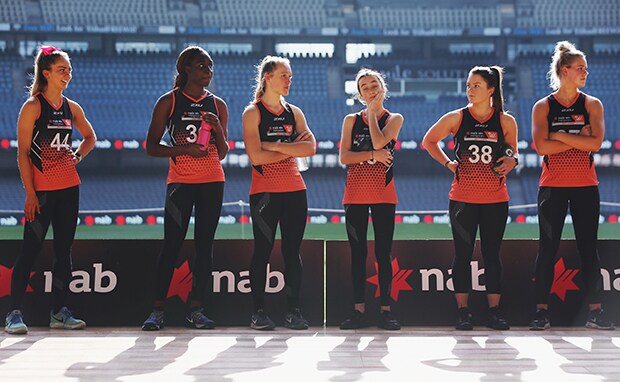This Tuesday and Wednesday, 36 of the nation's top young female footballers will take part in the NAB AFL Women's Draft Combine in Melbourne.
But what tests are actually involved, and what's the rationale for holding the combine?
The Combine sees players undergo a combination of physical and footy skills testing, along with interviews with prospective clubs ahead of the NAB AFL Women's Draft on October 23.
Physical assessments involve tests for agility, running vertical leap, standing vertical jump, a 20-metre sprint, a two-kilometre time trial and the relatively recent addition of the yo-yo test, which focuses on repeat running efforts.
The NAB AFLW Academy high-performance manager Hannah Squires said the physical tests are designed to replicate the actions seen on a football field.
"The vertical jump can be a measure of a player's ability to jump to get a mark over an opponent, for instance," Squires said.
"In terms of agility, can they change direction at quick speed to get around or fend off a player?"
The yo-yo test replaced the beep test last year as the interval test of choice. It measures aerobic fitness (or running capacity) and a player's ability to run at relatively high speeds with shorts breaks in the middle.
"Football's a stop-start sport, you're not running flat out all the time. The yo-yo is a better test of the type of running players do in football," Squires said.
"Players get a bit of a run-up, run hard, then walk to a particular point, then run again. The speed at which you have to run increases at particular levels, so it's similar to the beep test, but is a lot more realistic to the game of football."
The physical tests are complemented by skill testing, including kicking drills. Anthropometric measurements are also taken, which relate to the size and strength of the body, including height, weight and arm-span.
"The combine is about working out what (players') footballing strengths and weaknesses are and then looking at what type of athlete they are, which is where the physical tests come in," she said.
"Together, you have a really good idea of how well-rounded the player is, including their raw skills, technique and potential to improve. Throw in the interviews and you get an understanding of the person they are, too."

In the lead-up to this week, Squires has been working closely with the 20 Academy members who have been invited to the Combine.
"I gave them a seven-week program. It starts generalised, based on fitness, and then becomes specific to the testing, with some running and cross-training sessions and some power work in the gym," she said.
"We send the program to their states, and then their strength and conditioning coach takes it from there," she said.
"We just make sure the girls are constantly supported, that they know they can best prepare themselves without feeling overwhelmed. I've kept in contact with them over the seven weeks to make sure they're okay.
"You have to put it in perspective for them. They've got so many challenges and the messages I get back are, 'I'm really nervous,
"You can only do what you can do and try your best. They're very remarkable young women, that's for sure."



